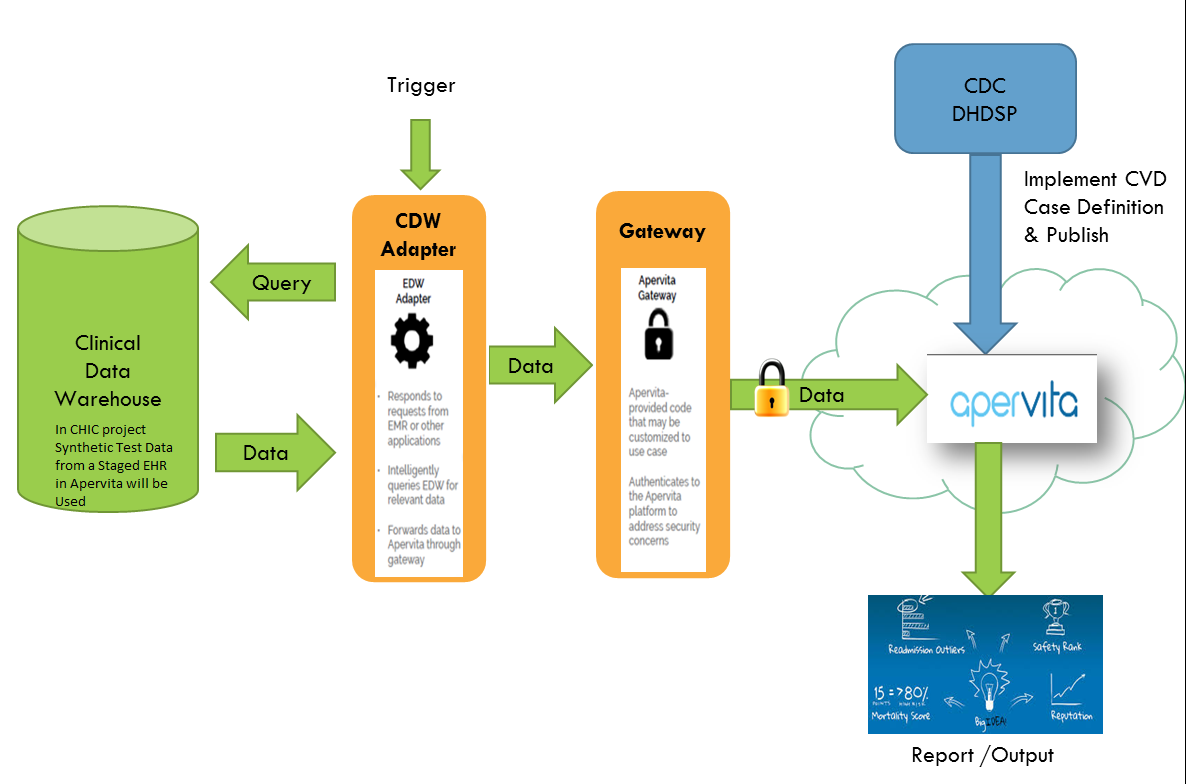A Cloud Based Analytics Approach for EHR based Cardiovascular Disease (CVD) Surveillance
Project Name: A Cloud Based Analytics Approach for EHR based Cardiovascular Disease (CVD) Surveillance
Project Status: Proposed
Point of Contact: Asha Krishnaswamy
Center: National Center for Chronic Disease Prevention and Health Promotion
Keywords: Clinical Data Warehouse, Apervita, CDW Adapter, Gateway, Cardiovascular Disease Algorithms, EHR, HL7, Data Elements, Technical Standards
Project Description: Background: Objective 10 of the Stage 3 Meaningful Use final recommendation promotes the use of certified electronic health record (EHR) technology for immunization , specialized registries reporting, syndromic surveillance and electronic laboratory data reporting to state, territorial, local, and tribal (STLT) public health agencies. As EHRs are increasingly becoming the standard in health care, there is great potential to enhance public health chronic disease surveillance by using clinical information in EHRs - to monitor prevalence, treatment, and control of health conditions including cardiovascular disease, tobacco use, and diabetes. State DOHs are already building capacity to receive and use immunization and syndromic surveillance data as part of the meaningful use requirements; however, most state DOHs have not engaged in broader activities to tap into EHR data for population health needs of chronic disease, injury, occupational health, and beyond.
Healthcare systems often employ a Clinical Data Warehouse (CDW) as a component of their information technology infrastructure and use custom interfaces to query, filter and extract data for reporting purposes. This approach is challenging and burdensome due to the associated complexity of definitions, changes in reporting requirements over time and inconsistent implementations. Existing EHRs and CDW technologies in conjunction with innovative cloud based analytic infrastructures could potentially mitigate some of these challenges. A cloud based analytic approach will increase capacity for chronic disease management and surveillance with minimal burden on health care providers and increase consistency by adopting a “build once and use many” philosophy. A successful demonstration of a technical approach that allows healthcare entities to use standardized, readily available and community vetted analytics in a cloud environment will increase provider capacity for population health management as well as public health capacity for CVD surveillance.
Project: Division of Heart Disease and Stroke Prevention (DHDSP) in collaboration with Office of Informatics and Information Resource Management (OIIRM) is applying for a grant to: 1. Develop a machine readable CVD case definition and surveillance algorithm to use within a cloud-based health analytics platform; 2. publish and validate the algorithm within a cloud-based infrastructure to efficiently and accurately identify CVD cases within EHRs; and 3. Develop technical guidance to implement and leverage the approach for other disease surveillance. Specifically, the requested $50,000 will support the evaluation of a cloud-based technical architecture that connects a health system’s EHR data to a CVD case definition and surveillance algorithm within a cloud infrastructure, and estimate cost of this technological approach. The EHR-agnostic Apervita cloud based analytic technology and infrastructure will be used to test this concept. In 2015, DHDSP, in collaboration with OIIRM, initiated an effort with Public Health Informatics Institute (PHII) and New York State DOH (NYS) to build, analyze, document the technical approaches, and assess DOH capacity for using EHR data for CVD Surveillance. One of the project deliverables includes documentation of the surveillance criteria and the case definition for hypertension control. These definitions will be implemented and tested in the proposed effort thus validating and promoting the concept for reuse. To validate the surveillance definitions, a batch of synthetic test data from a sandbox EHR system in the apervita platform will be utilized. The outcomes of the evaluation will inform whether a cloud-based analytic infrastructure supports maximization and efficiency of EHR-driven chronic disease management and surveillance by virtually connecting health systems to public
Deliverables:
- Develop and evaluate a machine readable CVD case definition and surveillance algorithm in the cloud analytic platform using synthetic patient data
- Develop technical requirements and document lessons learned
- Document cost estimates for implementing an EHR connected cloud based IT infrastructure for chronic disease case definition algorithms
Technical Architecture:

Impact:
- Enhance CVD identification and management by developing a machine readable CVD case definition algorithm that can be used across varying EHR implementations.
- Increase the efficiency, accuracy of CVD case detection from EHRs by using a cloud based CVD case definition and surveillance algorithm published by an authoritative stakeholder.
- Use cloud infrastructure to streamline chronic disease case definitions across all levels of public health.
- Maximize the use of EHRs to bridge the gap between clinical and public health activities for CVD and other chronic diseases via dissemination of guidance for the implementation.
- Leverage current technologies to reduce the risk for heart attacks, strokes, and other adverse chronic disease outcomes.
The technical documents developed through this funding can be extended based on the needs of other programs across the agency for use in their funding announcements thereby ensuring accountability, reducing redundancies, increasing efficiency, and enhancing automated surveillance efforts.
For more information about this project, please contact the CHIIC at chiic@cdc.gov or Brian Lee at Brian.Lee@cdc.gov
- Page last reviewed: January 10, 2017
- Page last updated: January 10, 2017
- Content source:


 ShareCompartir
ShareCompartir